
Designing the Starship Enterprise - By Matt Jefferies.
Matt Jefferies began his Star Trek career by visualizing the famous USS Enterprise NCC-1701. In the
process, he established the basic design elements that would be used for almost every Starfleet vessel.
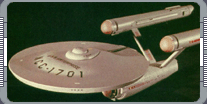 When Matt Jefferies started work on Star Trek's first pilot, "The Cage," literally nothing was in place.
Jefferies was given the job of designing the Enterprise and its bridge, while the original production designer,
Franz Bachelin, and his assistant, Pato Guzman, handled the rest of the sets. "In my approach to Star Trek I
wanted to be as practical as possible," Jefferies says. "I could tell Gene was serious enough, but I really
didn't know where to start. I knew the Enterprise was going to be
on the cutting edge of the future, but essentially he gave me the job of finding a shape, and I didn't know what
the shape looked like." Although Roddenberry knew a lot about his ship, he had never visualized it, and
consequently made the situation more complicated since he couldn't give Jefferies a detailed sense of
When Matt Jefferies started work on Star Trek's first pilot, "The Cage," literally nothing was in place.
Jefferies was given the job of designing the Enterprise and its bridge, while the original production designer,
Franz Bachelin, and his assistant, Pato Guzman, handled the rest of the sets. "In my approach to Star Trek I
wanted to be as practical as possible," Jefferies says. "I could tell Gene was serious enough, but I really
didn't know where to start. I knew the Enterprise was going to be
on the cutting edge of the future, but essentially he gave me the job of finding a shape, and I didn't know what
the shape looked like." Although Roddenberry knew a lot about his ship, he had never visualized it, and
consequently made the situation more complicated since he couldn't give Jefferies a detailed sense of
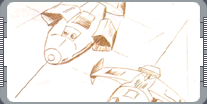 direction. According to Jefferies, Roddenberry was absolutely clear to avoid any resemblance to a 1960's rocket
ship. "Gene described the 100-150 man crew, outer space, fantastic, unheard-of speed, and that we didn't have
to worry about gravity. He had emphasizaed that there were to be no fins, no wings, no smoke trails, no flames,
no rocket.
direction. According to Jefferies, Roddenberry was absolutely clear to avoid any resemblance to a 1960's rocket
ship. "Gene described the 100-150 man crew, outer space, fantastic, unheard-of speed, and that we didn't have
to worry about gravity. He had emphasizaed that there were to be no fins, no wings, no smoke trails, no flames,
no rocket.
"To show fantastic speed he was talking about on air, I knew we were just going to have flash cuts; you cannot
sell speed by holding a vehicle, automobile, airplane, or whatever and moving the background. It just doesn't
work; it's going to have to come from infinity to you or the other way. So I wanted to keep it very simple, but
immediately identifiable - a shape that you could instantly pick out. There was a lot of floundering going on
because I didn't know where the hell we were going, and I had to start coming up with an envelope to work
outside of. I did hundreds of sketches. Gene liked a piece of this and a piece of that and a piece of
something else, so I tried to see what I could do with the pieces. I did have a lot
 of material from NASA on work that they were doing, and I was a member of the Aviation Space Writers'
Association and active as a consultant with the Air Force Museum in Dayton, so I did have a source for a lot of
what was being thought about. "Over a period of about three weeks I was getting more frustrated all the time,
but finally I came up with something I thought had possibilities. My thinking was, because of the ship's speed
there had to be terrifically powerful engines. They might be dangerous to be aroun, so maybe we'd better put
them out of the way somewhere, which would also make them what in aviation circles we call the QCU - quick
change units - where you could easily take one off and put another on. Then for the hull, I didn't really want
a saucer because of the term 'flying saucer,' and the best pressure vessel of course is a ball, so I started
playing with that. But the bulk got in the way and the ball just didn't work. I flattened it out and I guess we
wound up with a saucer! I did it in color on a black matt board, and by the time I finished I thought we
of material from NASA on work that they were doing, and I was a member of the Aviation Space Writers'
Association and active as a consultant with the Air Force Museum in Dayton, so I did have a source for a lot of
what was being thought about. "Over a period of about three weeks I was getting more frustrated all the time,
but finally I came up with something I thought had possibilities. My thinking was, because of the ship's speed
there had to be terrifically powerful engines. They might be dangerous to be aroun, so maybe we'd better put
them out of the way somewhere, which would also make them what in aviation circles we call the QCU - quick
change units - where you could easily take one off and put another on. Then for the hull, I didn't really want
a saucer because of the term 'flying saucer,' and the best pressure vessel of course is a ball, so I started
playing with that. But the bulk got in the way and the ball just didn't work. I flattened it out and I guess we
wound up with a saucer! I did it in color on a black matt board, and by the time I finished I thought we
 really had something. I rushed down to the mill, and the boys did the dish and the lower hull out of balsa
wood, and they said that as soon as the lathes were open they would do the engine pods. I said, 'No, just grab
some birch dowel,' so we put it together and put a hook in the top with a string.
really had something. I rushed down to the mill, and the boys did the dish and the lower hull out of balsa
wood, and they said that as soon as the lathes were open they would do the engine pods. I said, 'No, just grab
some birch dowel,' so we put it together and put a hook in the top with a string.
"When Gene and the NBC people came in - I think there were about eight of them - they did navigate to the color
piece, and I said, 'Well, if you like that, how about the model,' and held it up. Gene took it by the string
and immediately it flopped over, because the birch dowels were heavier! I had an awful time trying to unsell
that. And, of course, when our first show hit the air and TV Guide came out, they ran a picture of the ship on
the cover, upside down." Even when the shape was approved, that wasn't the end of Jefferies efforts. He
theorized that since space was an extremell dangerous place, starship engineers would not put any important
machinery on the outside of their vessel. This meant that, logically, the hull
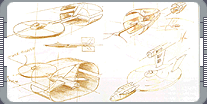 would be smooth. Not everyone agreed with Jefferies and he had to fight his corner. "I constantly had to fight
anyone who wanted to put surface details on the thing," he says. Another advantage of the smooth design was that
it would reflect light, and at this point it wasn't a foregone conclusion that the ship would be white. "I
thought the atmosphere or lack of it out there in space might produce different colors, and this gave us a
chance to be able to play light and to throw color on it."
would be smooth. Not everyone agreed with Jefferies and he had to fight his corner. "I constantly had to fight
anyone who wanted to put surface details on the thing," he says. Another advantage of the smooth design was that
it would reflect light, and at this point it wasn't a foregone conclusion that the ship would be white. "I
thought the atmosphere or lack of it out there in space might produce different colors, and this gave us a
chance to be able to play light and to throw color on it."
Jefferies was also responsible for the Enterprise's famous registry number. "I wanted a very simple number that
could be spotted quickly. You'd have to eliminate 3, 6, 8, and 9, so I just went for 1701, which incidentally
and coincidentally, happens to be very close to the license number on my airplane - NC-17740. But I have never
really stepped out and squashed the rumor that the number on the Enterprise came off my airplane." After the
number had been decided on, Jefferies would tell people that the Enterprise was Starfleet's 17th starship design
and that it was the first in the series hence the number '1701.'
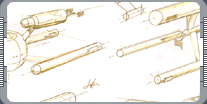
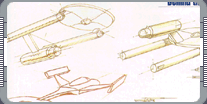

|
|
"DESIGNING THE STARSHIP ENTERPRISE" - FEBRUARY 2000 ISSUE 10 STAR TREK: THE MAGAZINE COPYRIGHT OF PARAMOUNT
PICTURES.
|